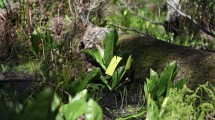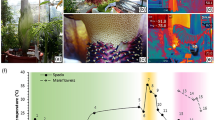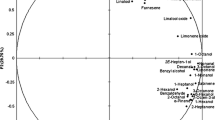Abstract
Four major volatile components emitted from flowers ofAbelia grandiflora were identified based on retention time using two capillary columns of different polarities and electron impact mass spectrometry. These are phenylacetaldehyde, benzaldehyde, 2-phenylethanol, and benzyl alcohol. A blend of these compounds was as effective as a cluster of flowers in stimulating upwind flight by maleTrichoplusia ni to the source in a wind-tunnel test. Phenylacetaldehyde or 2-phenylethanol were each as effective as the complete blend in stimulating source location by male moths. Attraction to a source of the synthetic blend was demonstrated in virgin males and females and mated males and females, but virgin moths of both sexes were more likely than mated moths to complete the sequence of behavioral responses necessary to locate the odor source.
Similar content being viewed by others
References
Aplin, R.T., andBirch, M.C. 1970. Identification of odorous compounds from male Lepidoptera.Experientia 26:1193.
Birch, M.C., Poppy, G.M., andBaker, T.C. 1990. Scents and eversible scent structures of male moths.Annu. Rev. Entomol. 35:25–58.
Cantelo, W.W. andJacobson, M. 1979. Phenylacetaldehyde attracts moths to bladder flower and to blacklight traps.Environ. Entomol. 8:444–447.
Creighton, C.S., McFadden, T.L., andCuthbert, E.R. 1973. Supplementary data on phenylacetaldehyde: An attractant for Lepidoptera.J. Econ. Entomol. 66:114–115.
Grant, G.G. 1971a. Feeding activity of adult cabbage loopers on flowers with strong olfactory stimuli.J. Econ. Entomol. 64:315–316.
Grant, G.G. 1971b. Scent apparatus of the male cabbage looper,Trichoplusia ni.Ann. Entomol. Soc. Am. 64:347–352.
Hagan, D.V., andBrady, U.E. 1981. Absence of detectable 2-phenylethanol inTrichoplusia ni, a reported pheromone of males.J. Ga. Entomol. Soc. 16:192–196.
Haynes, K.F. andBaker, T.C. 1989. An analysis of anemotactic flight in female moths stimulated by host odour and comparison with the males' response to sex pheromone.Physiol. Entomol. 14:279–289.
Hirai, K. 1982. Directional flow of male scent released byPseudaletia separata Walker (Lepidoptera: Noctuidae) and its repellent effect on adults and larvae of four noctuid and one phycitine moth.J. Chem. Ecol. 8:1263–1270.
Jacobson, M., Adler, V.E., Kishaba, A.N., andPriesner, E. 1976. 2-Phenylethanol, a presumed sexual stimulant produced by the male cabbage looper moth,Trichoplusia ni.Experientia 32:964–966.
Landolt, P.J. 1989. Attraction of the cabbage looper to host plants and host plant odor in the laboratory.Entomol. Exp. Appl. 53:117–124.
Landolt, P.J., andHeath, R.R. 1990. Sexual role reversal in mate-finding strategies of cabbage looper moths.Science 249:1026–1028.
Liu, S.-H., Norris, D.M., andMarti, E. 1988. Behavioral responses of female adultTrichoplusia ni to volatiles from soybeans versus a preferred host, lima bean.Entomol. Exp. Appl. 49:99–109.
Miller, J.R., andRoelofs, W.L. 1978. Sustained-flight tunnel for measuring insect responses to wind-borne sex pheromones.J. Chem. Ecol. 4:187–198.
Phelan, P.L., andBaker, T.C. 1987. An attracticide for control ofAmyelois transitella (Lepidoptera: Pyralidae) in almonds.J. Econ. Entomol. 80:779–783.
Ramaswamy, S.B. 1988. Host finding by moths: Sensory modalities and behaviours.J. Insect Physiol. 34:235–249.
Shorey, H.H., andHale, R.L. 1965. Mass-rearing of the larvae of nine noctuid species on a simple artificial medium.J. Econ. Entomol. 58:522–524.
Smith, C.E., Allen, N., andNelson, O.A. 1943. Some chemotropic studies withAutogrdpha spp.J. Econ. Entomol. 36:619–621.
Tingle, F.C., Heath, R.R., andMitchell, E.R. 1989. Flight response ofHeliothis subflexa (GN.) females (Lepidoptera: Noctuidae) to an attractant from groundcherry,Physalis angulata L.J. Chem. Ecol. 15:221–231.
Wiesenborn, W.D., andBaker, T.C. 1990. Upwind flight to flowers byPectinophora gossypiella (Lepidoptera: Gelechiidae).Environ. Entomol. 19:490–493.
Author information
Authors and Affiliations
Rights and permissions
About this article
Cite this article
Haynes, K.F., Zhao, J.Z. & Latif, A. Identification of floral compounds fromAbelia grandiflora that stimulate upwind flight in cabbage looper moths. J Chem Ecol 17, 637–646 (1991). https://doi.org/10.1007/BF00982132
Received:
Accepted:
Issue Date:
DOI: https://doi.org/10.1007/BF00982132




